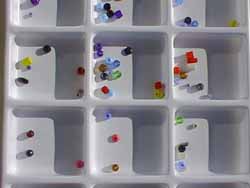without purchase of a site license.
CRUNCHING NUMBERS
 INDEX - MODULE 1 - MODULE 2 - MODULE 3
INDEX - MODULE 1 - MODULE 2 - MODULE 3
MODULE 4 - MODULE 5 - MODULE 6
 MODULE One
MODULE One 
Why build a database?
| 1) Why do we build databases?
We gather data together in databases in order to explore questions.
We may be looking for a relationship.
2) Who needs databases?
Collecting data about people in California or Mississippi is like taking the state's temperature.
3) What do databases look like? They are something like a bead tray . . .
and rows (across).
The table below is a dataset. It is a collection of numbers in rows and columns.
We can place the dataset information in a database if we want to sort and sift it. Later we may move it to a spreadsheet to do calculations. When we add field names and record names to a dataset, we change it into a database. In the example below, the words across the top row are the fields. The words listed down the side (states) are the individual records. Field Names
Take time to note how a database file is set up. It is different from a spreadsheet. A database file is comprised of "records" - each one of which is an entry with several "fields" telling about the record. In this case, each record is an American state. The fields contain important numbers about each state. Each field tells us some aspect of child well being. It may be the drop out rate or the infant mortality rate, for example. Later, when you work with the database program you will be able to sort the information. Each time the name of the state moves, all the other information associated with that state moves with it. In a spreadsheet, moving information in one column may not move the rest.
When you are done, please call your workshop leader over to see your ideas.
|
|
© 2000, Jamie McKenzie. All rights reserved. |
